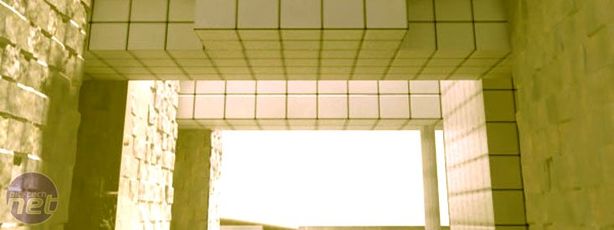What do you think the impact of this technology could be in terms of physical space, with regards to games and PCs?
At least 70% of the textures of your game could be replaced by procedural equivalents. 70% is a minimum number of textures you can replace, in actuality the likelihood is you can replace more. So for example: replace 80% of the textures and if those textures occupy 50% of your game size, the overall game size would end up a little less than 50% smaller.
I have some actual examples from a recent game, Roboblitz. In this game, we replaced about 95% of the textures. The game has 6 levels and for each level the developers would use 80MB of compressed textures. So, let's do the numbers, a total of 6x80=480MB. Using our tools we replaced the 480MB with about 3MB of procedural data, a pretty spectacular decrease in game size.
The game now fits within 50MB and can be downloaded through Xbox Live. Without our technology this game would weigh approx 50MB-3MB+480MB=527MB. So the gain, for Roboblitz, we saved 90% of the entire game size. That is a massive gain for the developers which allows them to reach the Live audience - something they couldn't otherwise have done.

How long have you been around as a company? What is your history?
I created Allegorithmic one and a half years after I completed my PhD in 2001. We've received a lot of help/prizes/medals from the French government for the project due to us being considered 'innovative'. At the beginning we focused on VFX and Animation by focusing mainly on the authoring tools and the technology.
We decided to make the move to the games industry one and a half years ago and focused on developing ProFX, our tools suite. We worked closely with Naked Sky on its Roboblitz game and they provided us with the access to the Microsoft XDK and Epic's Unreal Engine 3. In the mean time, we've been giving talks at various Games Developers Conferences and trying to make developers aware of the technology.
What would you say to companies like Crytek or Valve and the way they use their textures?
Valve has a very interesting approach to things with Steam. I love the concept of digital distribution. The way that game developers use the bitmap textures so far on that service, I would say it's the best you can do with bitmap textures - it's very impressive.
However, at some point this technology becomes limited. By this, I don't mean that bitmaps are visually limited, I say bitmap textures have limited advantages given that they are causing a lot of difficulties for next-gen game development given the sizes required to accommodate them.
Do you have any rivals at the moment? Does anyone do anything similar to you?
On the authoring side, there are about four companies offering ways to design procedural textures. We have the most powerful, modern and patented approach and on the engine side, we are the only ones to propose an engine for next-gen consoles and PCs. In conclusion, the market exists, but as Torsten Reil (CEO, Natural Motion) says: "Allegorithmic is the leader in real-time texture synthesis".

Is what you guys are doing the opposite of Id software's megatexturing, which John Carmack is rolling out in Quake Wars: Enemy Territory?
Kind of. I think what Carmack made is very impressive, but we attack the problem of texture sizes from the other side. Funny you mention this, our business developer used to work at Id so he talks with John quite often.
Do you know what John thinks of your approach?
He's chosen his side.
At least 70% of the textures of your game could be replaced by procedural equivalents. 70% is a minimum number of textures you can replace, in actuality the likelihood is you can replace more. So for example: replace 80% of the textures and if those textures occupy 50% of your game size, the overall game size would end up a little less than 50% smaller.
I have some actual examples from a recent game, Roboblitz. In this game, we replaced about 95% of the textures. The game has 6 levels and for each level the developers would use 80MB of compressed textures. So, let's do the numbers, a total of 6x80=480MB. Using our tools we replaced the 480MB with about 3MB of procedural data, a pretty spectacular decrease in game size.
The game now fits within 50MB and can be downloaded through Xbox Live. Without our technology this game would weigh approx 50MB-3MB+480MB=527MB. So the gain, for Roboblitz, we saved 90% of the entire game size. That is a massive gain for the developers which allows them to reach the Live audience - something they couldn't otherwise have done.

More gritty shots.
How long have you been around as a company? What is your history?
I created Allegorithmic one and a half years after I completed my PhD in 2001. We've received a lot of help/prizes/medals from the French government for the project due to us being considered 'innovative'. At the beginning we focused on VFX and Animation by focusing mainly on the authoring tools and the technology.
We decided to make the move to the games industry one and a half years ago and focused on developing ProFX, our tools suite. We worked closely with Naked Sky on its Roboblitz game and they provided us with the access to the Microsoft XDK and Epic's Unreal Engine 3. In the mean time, we've been giving talks at various Games Developers Conferences and trying to make developers aware of the technology.
What would you say to companies like Crytek or Valve and the way they use their textures?
Valve has a very interesting approach to things with Steam. I love the concept of digital distribution. The way that game developers use the bitmap textures so far on that service, I would say it's the best you can do with bitmap textures - it's very impressive.
However, at some point this technology becomes limited. By this, I don't mean that bitmaps are visually limited, I say bitmap textures have limited advantages given that they are causing a lot of difficulties for next-gen game development given the sizes required to accommodate them.
Do you have any rivals at the moment? Does anyone do anything similar to you?
On the authoring side, there are about four companies offering ways to design procedural textures. We have the most powerful, modern and patented approach and on the engine side, we are the only ones to propose an engine for next-gen consoles and PCs. In conclusion, the market exists, but as Torsten Reil (CEO, Natural Motion) says: "Allegorithmic is the leader in real-time texture synthesis".

Dystopian sci-fi environments also look pretty good using procedural textures.
Is what you guys are doing the opposite of Id software's megatexturing, which John Carmack is rolling out in Quake Wars: Enemy Territory?
Kind of. I think what Carmack made is very impressive, but we attack the problem of texture sizes from the other side. Funny you mention this, our business developer used to work at Id so he talks with John quite often.
Do you know what John thinks of your approach?
He's chosen his side.

MSI MPG Velox 100R Chassis Review
October 14 2021 | 15:04








Want to comment? Please log in.